New Stuff[hide]
Musicos: Juan Formell
Musicos: Yordamis Megret Planes
Musicos: Yasser Morejón Pino
Musicos: José Luis "Changuito" Quintana...
Musicos: Dennis Nicles Cobas
Fotos: Eli Silva
Grupos: Ritmo Oriental : 1988 - Vol. IX - 30 a...
Musicos: Rafael Paseiro Monzón
Musicos: Jiovanni Cofiño Sánchez
Fotos: Tom Ehrlich : 2024 Monterey Jazz, P...
Resenas: Vacilón Santiaguero (Circle 9 ...
Staff: Bill Tilford
Fotos: Tom Ehrlich : 2024 Monterey Jazz, P...
Fotos: Tom Ehrlich : 2024 Monterey Jazz Fe...
Photos of the Day [hide]
SpanishEnglishHistory - Los Charangueros de Ayer, pt. 1
Los Charanguero de Ayer, Part 1
by Majela Serrano
(additions by Kevin Moore)
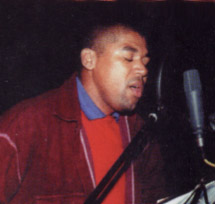
Leo Vera, whose full name is Leocidio, was born in Guantánamo a it was there that he began his artistic career.
He's sung professionally since child, in many groups and in many different genres.
From Guantanamo he moved to the Isla de la Juventud, where he continued to sing with various groups. From there he moved to Havana and in 1991 he began to sing with Charanga Habanera just as the band began it seminal role in the history of Timba. He stayed with David Calzado for a period of three years.
 In 1994 he joined Chucho Valdés' Irakere, until he and saxophonist César López left to form the a new group, "Havana Ensemble". Later he joined Giraldo Piloto's Klimax. He only performed with the band for a few months, but recorded several of the lead vocals on their most recent CD, "Oye Como Va", including "La Número Cien".
In 1994 he joined Chucho Valdés' Irakere, until he and saxophonist César López left to form the a new group, "Havana Ensemble". Later he joined Giraldo Piloto's Klimax. He only performed with the band for a few months, but recorded several of the lead vocals on their most recent CD, "Oye Como Va", including "La Número Cien".
Finally, about two and a half years ago, he formed his own group, which palys frequently at Café Cantante del Teatro Nacional.
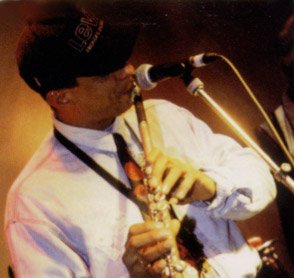 Jorge Emilio Maza played sax and flute for both Charanga Habanera and Charanga Forever, and was also musical director of La Forever for a period of time..
Jorge Emilio Maza played sax and flute for both Charanga Habanera and Charanga Forever, and was also musical director of La Forever for a period of time..
Maza, a founding member of Charanga Habanera stayed witht e group for ten years, from 1988 to 1998. He didn't stay for very long with La Forever and is currently playing with Jesús Alemany's "Cubanismo" with such musicians as Efraín Ríos, Roberto Riverón, Carlos Alvarez, "El Panga", "Peruchín", etc.
I understand he was a member of the Banda Nacional de Conciertos after finishing his studies, but I'm not sure if he attended the ENA or Amadeo Roldán.
I last saw him a year and a half ago in Havana, where he was recorded with Cubanismo on an album that featured Tata Gúines as a guest artist.
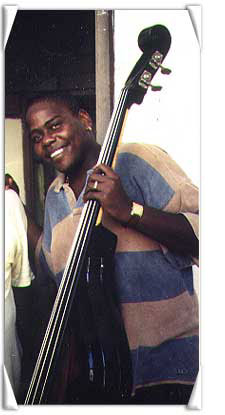 Pedro Pablo Gutiérrez - (photo by Allan Johnston)
Pedro Pablo Gutiérrez - (photo by Allan Johnston)
Pedro Pablo Gutiérrez was the bassist of La Habanera, La Forever, and is now the bassist and leader of "La Rebambaramba".
Timba.com has an interview with Pedro in both English and Spanish and also a special article on his bass-playing by Allan Johnston.
The Bass Style of Pedro Pablo Gutiérrez by Allan Johnston.
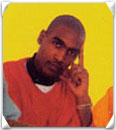 Juan Carlos González has written an extensive article for timba.com about his time with Charanga Habanera.
Juan Carlos González has written an extensive article for timba.com about his time with Charanga Habanera.
He began with Charanga Habanera in the late 80's and left, just after the suspension, in 1997 to become musical director of "Danny Lozada y su timba cubana".Later he became musical director of "Ladysalsa", a famous all-woman band now directed by Orlando Leyva. Juan Carlos later played with Charanga Forever before moving to his current home in Barcelona Spain.
I understand that Juan Carlos is now serving as musical director for the Cuban singer Lucrecia. He has promised to continue his article and bring us up to date on his career after Charanga Habanera.
Orlando Miguel Leyva Saavedra played bongoes for both Charanga Habanera and Charanga Forever.
His incredible gynastic abilities made him a key part of the stage show from 1991 to 1998, when he moved over to Charanga Forever for a period of two years.
His mother, Sonia Saavedra, was the director of the group "Ladysalsa", and today Orlando has taken over that job. He also plays bongoes with the band.
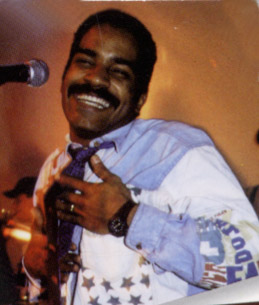 Mario Antonio Jiménez Sánchez "Mayito" y "Sombrilla", is the last of the survivors of La Forever. (Or should we say "The Last of the Mohicans"?) He began in 1991 when he replaced Luis Alberto Leyva, a tale which is told in JC González' article.
Mario Antonio Jiménez Sánchez "Mayito" y "Sombrilla", is the last of the survivors of La Forever. (Or should we say "The Last of the Mohicans"?) He began in 1991 when he replaced Luis Alberto Leyva, a tale which is told in JC González' article.
In 1998 he left for Charanga Forever,.where he remains today. As Manolín says (or said): "hasta que ñangue, mi gente". ("until it becomes ancient history, my friends")
Sombrilla sang well over a dozen of Charanga Habanera's most unforgettable classics and each is described in detail in our extensive articles on the four albums of the original CH.
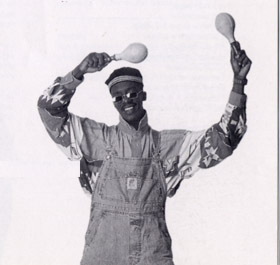 Víctor Sagarra "Vitico" o "El Vitis Man" is the song of the famous Cuban athlete, Alcides Sagarra, and must have at some point in his life considered a career in sports himself (quizás hasta llegó a serlo).
Víctor Sagarra "Vitico" o "El Vitis Man" is the song of the famous Cuban athlete, Alcides Sagarra, and must have at some point in his life considered a career in sports himself (quizás hasta llegó a serlo).
But he wound up studying music instead, and like Polledo, he joined La Habanera in 1991, quit in 1998 and remains with La Forever to this day.
Vitico is well known among Cuban musicians for his sense of humor and his imaginative knack for slang. He came up with a number of catchy phrases such as "Hey, you, loca", which earned him the composer's credit for that song, and nicknames like "Cucurucho".
According to Kevin's one of Vitico's greatest accomplishments was to invite me to my first Charanga Habanera rehearsal! That fateful day just happened to be Vitico's birthday, October 8th, 1997. After I went once, I just kept going and going!
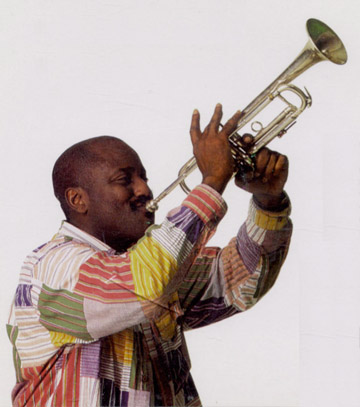 Pedro Leonel Polledo Hernández, although a trumpeter and not a singer, is nevertheless one of the voices most frequently heard in the concerts of Charanga Forever, and before that, Charanga Habanera. His rapping and playful bantering with the audience became a popular part of such songs as "Hagamos un Chen".
Pedro Leonel Polledo Hernández, although a trumpeter and not a singer, is nevertheless one of the voices most frequently heard in the concerts of Charanga Forever, and before that, Charanga Habanera. His rapping and playful bantering with the audience became a popular part of such songs as "Hagamos un Chen".
He played with La Habanera from 1991 to 1998.
He's now leader and last remaining original member of Charanga Forever.
 Juan Manuel Arranz Calzado, as his name indicates, is David's cousin. Originally David called him to substitute temporarily for Juan Carlos González and he wound up staying with the group, with he and González switching back and forth between piano and synth. He played piano on the traditional pieces and also "Para el Llanto", "Me Sube la Fiebre" and others. He also did some arranging for the group, including "Homenaje a los Cabilleros"
Juan Manuel Arranz Calzado, as his name indicates, is David's cousin. Originally David called him to substitute temporarily for Juan Carlos González and he wound up staying with the group, with he and González switching back and forth between piano and synth. He played piano on the traditional pieces and also "Para el Llanto", "Me Sube la Fiebre" and others. He also did some arranging for the group, including "Homenaje a los Cabilleros"
He joined Charanga Forever, along with the others, in 1998 and did more writing arranging for them, but left the group after less than a year and relocated to Chile.
In 2000, he returned to Cuba to put together a group for a long-term engagement in Chile which included his wife roxana and Sandier as singers.
A bit of trivia: those who have seen Charanga Habanera's Cuban television appearances may recall a cute little boy who would hold a microphone on stage and pretend to sing along with the band. That was Manolito's song Arturo Manuel.
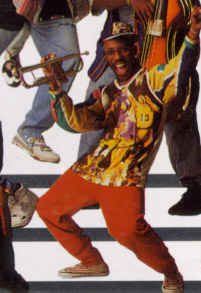 Victorino Patterson played trumpet for Charanga Habanera from 1990 to the summer of '98 when he left for Charanga Forever, but no longer plays with them.
Victorino Patterson played trumpet for Charanga Habanera from 1990 to the summer of '98 when he left for Charanga Forever, but no longer plays with them.
We don't have any fresh news on Victorino, but we'll continue our investigations.
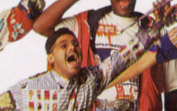 Osmil René Monzón Díaz was added to La Charanga in 1996 when David Calzado decided to expand the horn section by adding a lead trumpeter, en el año 1996, para reforzar la cuerda de los metales con una trompeta lead. Por lo tanto, Osmil estuvo con David muy poco tiempo, sólo 2 años, porque en 1998 se va a la Forever.
Osmil René Monzón Díaz was added to La Charanga in 1996 when David Calzado decided to expand the horn section by adding a lead trumpeter, en el año 1996, para reforzar la cuerda de los metales con una trompeta lead. Por lo tanto, Osmil estuvo con David muy poco tiempo, sólo 2 años, porque en 1998 se va a la Forever.
Actualmente no se encuentra tocando en este grupo, pero tampoco sabemos de sus ocupaciones actuales.
 Eduardo Lazaga Salgado, son of Ritmo Oriental leader Enrique Lazaga, started with La Charanga in 1991 and played timbales on the first four albums. He left before the famous suspension and was replaced by Gilberto Moreaux. Our European sources report that he's been living in France for some time now. We're in the process of trying to learn what else has happened since then in the career of this important percussionist since his departure from La Charanga.
Eduardo Lazaga Salgado, son of Ritmo Oriental leader Enrique Lazaga, started with La Charanga in 1991 and played timbales on the first four albums. He left before the famous suspension and was replaced by Gilberto Moreaux. Our European sources report that he's been living in France for some time now. We're in the process of trying to learn what else has happened since then in the career of this important percussionist since his departure from La Charanga.
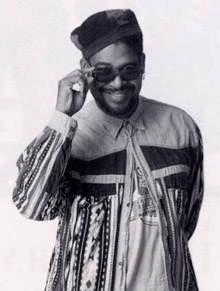 Pedro César Fajardo Alzaga also came from a musical family. His mother Oria Olga is a well-known professor of piano and music theory in Havana.
Pedro César Fajardo Alzaga also came from a musical family. His mother Oria Olga is a well-known professor of piano and music theory in Havana.
His younger sister Norka is also a pianist and has the special distinction of having been the first piano teacher of Iván "Melón" González.
Pedrito continued his studies while he was in Charanga Habanera and eventually graduated as a violinist from the ISA (Instituto Superior de Arte). He played and recorded with Charanga Habanera fro m1989 to 1994 when he left for his present job with Los Van Van.
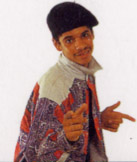 His complete name is Joe Michel Maza Márquez. He was born on March 16, 1978 into an incredibly musical family.
His complete name is Joe Michel Maza Márquez. He was born on March 16, 1978 into an incredibly musical family.
Of course, Michel was no exception and he enrolled in the music school "Manuel Saumell" specializing in piano, but that didn't last very long because he said he wanted to be a baseball player!
In 1995, at age 16, he acquired the nickname "El menor de la salsa", when he became the youngest member of a famous band -- David Calzado's Charanga Habanera. He sang many of the group's biggest hits, beginning with Nube pasajera , his first song as lead singer.
He stayed with La Charanga for four years, surviving even the famous breakup of 1998, although he only stayed on for a few more months. In February of '99 he left the group because of health problems. After a short period of inactivity, he joined Issac Bocalandro's Charanga Forever.
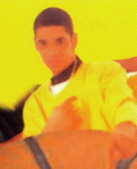 In mid-2000 he finally formed his first group as a leader, "Michel y la bola".
In mid-2000 he finally formed his first group as a leader, "Michel y la bola".
He left "La Bola" for "Banda Meteoro" where he made a few recordings, but the latest news is that he's now this group as well and has formed still another, "Michel y la tentación".
Michel has also participated in a number of other musicial projects, both in Cuba and abroad, including all-start tributes to Juan Formell and Pablo Milanes, Calixto Oviedo's "La recompensa" and the new group, "Sol y Soul".
Gilberto Moreaux Soto has played timbales with PG, Bamboleo, Charanga Habanera and Charanga Forever, in that order and is now living and playing in Canada
The only thing I know about his early career is that he played with Conjunto Artístico de las FAR. I believe he was also a member of "Los 10 de la salsa", the group which later changed its name to "Manolín, el Médico de la salsa".
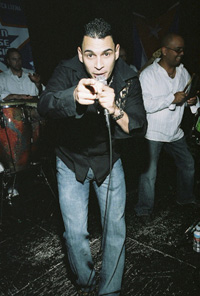 Dany Lozada started his career with Conexión Salsera and joined la Charanga in 1996. He wrote and sang many of the best songs on the masterpiece album Tremendo delirio.
Dany Lozada started his career with Conexión Salsera and joined la Charanga in 1996. He wrote and sang many of the best songs on the masterpiece album Tremendo delirio.
We have an extensive section on Dany's career as a bandleader, which began with "Dany Lozada y su Timba Cubana", with Juan Carlos González as pianist, arranger and musical director, formed immediately after the famous 6-month suspension of 1997. This group recorded one of timba's greatest albums, Tanto le pedí. Lozada now lives in the US and México and plays frequently in California and New York.



















